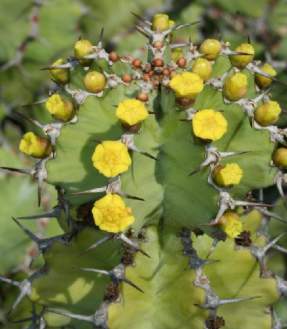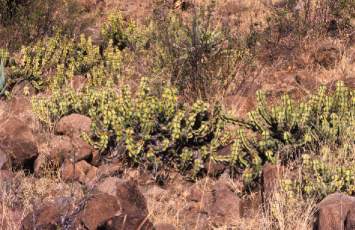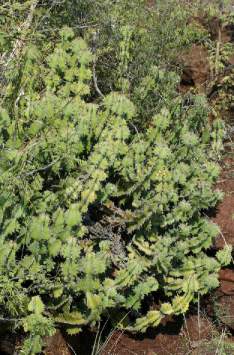Euphorbia barnardii
Euphorbia barnardii A.C.White, R.A.Dyer & B.Sloane
Family: Euphorbiaceae
Common names: mokgwakgwatha (Pedi)
Introduction
Euphorbia barnardii is an unusual succulent shrub endemic to the Limpopo Province.
Description
Description
Euphorbia barnardii is a spiny succulent which is seldom higher than 0.75 m, with a sub-tuberous main root and much reduced stem which produces a few or many branches. These branches are 5- to 6-angled and constrict at intervals into segments up to 100 x 40-70 mm, and are usually thickest near the base. The spines are in pairs about 10 mm apart along the angles, up to about 10 mm long, closer together and shorter on the constricted portions of the angles. Leaves are rudimentary and deciduous (soon falling).
The inflorescences appear above the spines on the apical section of the branches. The inflorescences (flowering part of the plant) consist of three cymes (inflorescence branch) that are vertically arranged each with 3 yellowish cyathia (compact inflorescence; looks like a small flower). Mature plants flower predominantly between May and June and the capsules are formed from July to August.
Conservation Status
Status
Euphorbia barnardii is a rare species that is endemic to the Limpopo province. It is assessed as Endangered (EN) on the Red List of South African Plants.
Mass extinction of species is primarily due to large-scale habitat destruction caused by human activities. Euphorbia barnardii occurs at one such area, the Sekhukhuneland Centre of Endemism. This taxon was in the past threatened by harsh environmental conditions, habitat destruction due to over-grazing, erosion, mining activities and illegal collection, which resulted in low population numbers. These threats are progressively worsening; fortunately illegal collection seems to have subsided. Trampling by livestock, especially cattle, appears to be negatively affecting the plants as it damages the terminal segments, which leads to low reproduction output and increased susceptibility to opportunistic bacterial wilt pathogens. Potential future threats include increased mining activities and development due to road widening and human habitation.
A study conducted in 1998 by Knowles & Witkowski (2000) found five populations totaling 10783 plants. But, on a visit in September 2006, only three populations were found and it appeared that the numbers had decreased drastically.
In the Bewaarskloof population, about 500 plants were counted in 1982, but on a visit in 2007 only 10 live plants and numerous dead ones were counted.
Distribution and habitat
Distribution description
Euphorbia barnardii is a Limpopo endemic and is restricted to the Bewaarskloof Nature Reserve and some few isolated norite hills in the magnificent Leolo Valley. Euphorbia barnardii occurs in mixed bushveld and sourish mixed bushveld on the slopes of low hills consisting of banded ironstone and noritic rock formation. This vegetation type is associated with plants such as Aloe dolomitica and Euphorbia schinzii. The plants of E. barnardii are found growing between boulders in a gritty, well-drained, sandy soil on north and northwestern aspects at altitudes of 900-1100 m.
Derivation of name and historical aspects
History
Euphorbia barnardii is named after its discoverer, W.G. Barnard, who first collected it in Sekhukhuneland in 1935. Only four localities were found on a few farms east of Leolo Mountain. In 1994 it was listed as Endangered by the Transvaal Threatened Plant Programme because only three populations totaling 1150 plants were found.
Euphorbia barnardii is, to some degree, related to E. cooperi and E. grandialata, but differs so much in habit that there cannot be much confusion regarding its identification. E. restricta, another rare endemic species may confuse the uninformed as it resembles E. barnardii on a miniature scale. In general appearance, E. restricta suggests a stunted form of E. barnardii. I would recommend a taxonomic study on whether they can be reliably separated.
Ecology
Ecology
Euphorbia barnardii is pollinated by insects. It has been previously documented that certain flies, bees and wasps tend to visit the flowers. The seeds are dispersed by ejection caused by the building up of tension and constriction of the capsules as they dry out on ripening. At a critical point, the tension in the capsule increases and it explodes with such force that seeds are shot out metres away from the parent plant. Seeds are freshly dispersed for the first spring rains.
Uses
Use
According to S.M. Matemane Masole at Thlago Environmental Services, Polokwane, plants are poisonous if ingested but are used locally in native medicine for treating sores. Animals avoid eating Euphorbia barnardii and its 'bigger cousin' E. cooperi, because of the poisonous latex. A smear on soft tissue can result in blisters and a drop in the eye may lead to blindness. I personally experienced burning sensations in the throat and skin after touching and standing next to a plant bleeding latex.
Growing Euphorbia barnardii
Grow
The propagation of Euphorbia species can be done from cuttings, seeds, grafting and possibly tissue culture. Euphorbias must be grown in a well-drained soil without clay. This is essential for the survival of these plants as it protects them from frost and cold temperatures. The plants enjoy fairly strong light in which to grow but should be protected from direct sunlight in the middle of summer to prevent the occurrence of sunburn. Good ventilation is essential for plants grown indoors to keep them in a healthy condition. Euphorbias, and especially succulent species, must never be over-watered. The plants should be given water only if the medium in which they grow dries out completely. This will prevent the plant rotting from the base as well as inhibiting the formation of various fungal and bacterial diseases associated with moisture. Damage to the terminal segments may lead to lowered reproductive output and increase susceptibility to opportunistic bacterial wilt pathogens.
References
- Boyd, W.M. 1994. Conservation plan : Euphorbia barnardii. Chief Directorate of Nature and Environmental Conservation, Pretoria. Unpublished report: TN 6/1/3/3/1.
- Knowles, L. & Witkowski, E.T.F. 2000. Conservation biology of the succulent shrub, Euphorbia barnardii, a serpentine endemic of the Northern Province, South Africa. Austral Ecology 25: 241-252.
- Van Wyk, B-E., Van Heerden, F. & Van Oudtshoorn, B. 2002. Poisonous plants of South Africa. Briza Publications, Pretoria.
- White, A., Dyer, R.A. & Sloane, B.L. 1941. The succulent Euphorbieae, vol. 2. Abby Garden Press. Pasadena, California.
Credits
Pethole Manyama
CREW Programme
May 2008
Plant Attributes:
Plant Type: Shrub, Succulent
SA Distribution: Limpopo
Soil type: Sandy, Loam
Flowering season: Autumn, Winter
PH: Acid, Neutral
Flower colour: Yellow
Aspect: Full Sun
Gardening skill: Average
Special Features:
Horticultural zones











Rate this article
Article well written and informative
Rate this plant
Is this an interesting plant?
Login to add your Comment
Back to topNot registered yet? Click here to register.